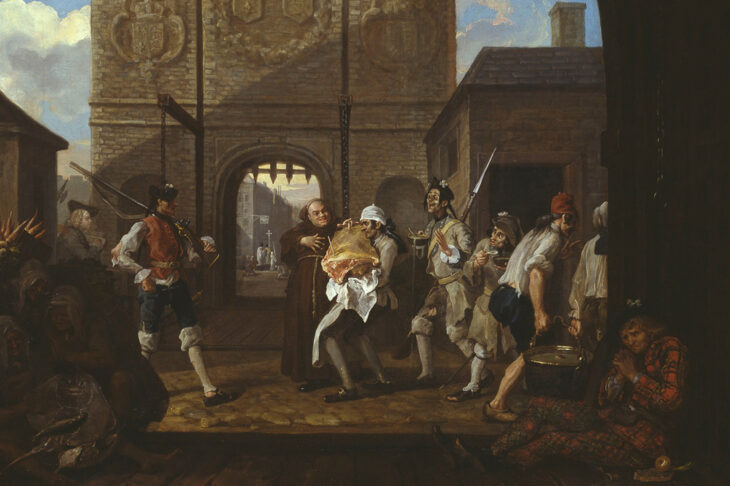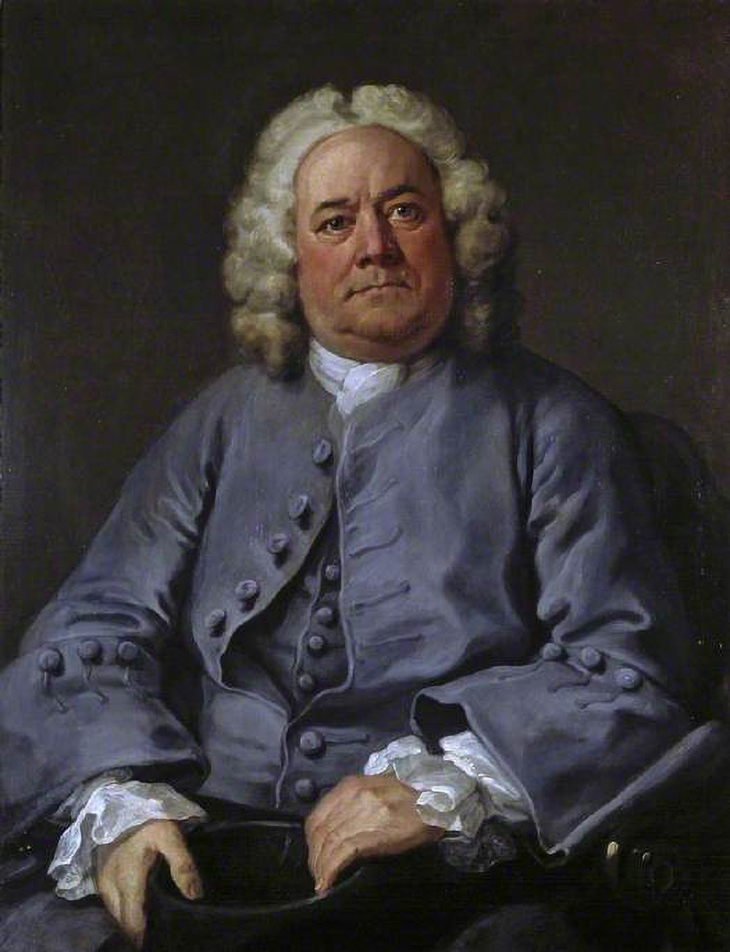In 1748, William Hogarth was arrested at Calais on suspicion of spying, after he was caught sketching part of the French fortifications. Once back on English soil, his riposte was a painting. O, the Roast Beef of Old England (The Gate of Calais) shows Calais populated by various national stereotypes: an overfed monk; an underfed grenadier; a group of superstitious peasant women, and a shivering tartan-clad Jacobite. Hogarth himself appears in the background, sketching the titular gate, with a hand and halberd coming down on his shoulder.
O, the Roast Beef of England (The Gate of Calais) (1748), William Hogarth. Tate, London

Self-Portrait (1739), Cornelis Troost. Rijksmuseum, Amsterdam

The story typifies the popular image of Hogarth, as a bluff, scrappy and above all insular artist-engraver. It was an image Hogarth himself assiduously propagated. His Self-Portrait of 1745 shows his dogged features gazing out of an illusionistic painting within a painting, and resting on books by the (to Hogarth’s mind) pointedly English writers Shakespeare, Milton and Swift. For the Victorians, such nationalism was a virtue. ‘Hogarth, be it his boast,’ wrote the Art Journal in 1862, ‘was […] a painter essentially English both by the character of his subjects and in the singular independence of his genius.’ Twentieth-century art historians were not so sure. At Tate Britain, The Gate of Calais hangs beside a still-life by Jean-Baptiste-Siméon Chardin, calling attention to the similarities between Hogarth’s bravura rendition of the eponymous fleshy side of beef, and the virtuosic depiction of meat and crockery characteristic of his French contemporary. Meanwhile, Hogarth’s self-confident Self-Portrait hangs next to a remarkably similar self-portrait by the Amsterdam-born Cornelis Troost, painted in 1739. Troost also uses the trick of a portrait within a portrait, but his palette is daubed with thick blobs of paint, a playful twist on the painting’s interplay between illusion and reality.
‘Hogarth and Europe’ follows on from the work by scholars such as Frederick Antal and, more recently, Robin Simon, arguing that Hogarth always looked outward. It places him in his national and international context, beside such artists as Nicolas Lancret, Pietro Longhi, and Giuseppe Crespi. Many of these also explored the themes for which Hogarth is celebrated: the contemporary city, the urban underworld, and modern morals and manners. Hogarth’s Enraged Musician, with its cacophony of city types – the milk maid, the oboe player, the drummer boy, and the ballad seller – is displayed beside both Paul Sandby’s Cries of London and Étienne Jeaurat’s series on urban Paris, whose inhabitants have all the teeming variety and noise of Hogarth’s dizzying Southwark Fair. These juxtapositions make for a visual feast, though their number often makes it hard to tell whether the focus is Hogarth’s relationship with Europe, or the relationship between European artists (including Hogarth) and the 18th-century city.
As the curators note, this was a time of massive urban expansion and economic growth, underpinned by the slave trade, visible in everything from the trade in luxury goods to the personal histories of slavers and art patrons like Alderman Beckford, who owned A Harlot’s Progress, A Rake’s Progress and, at the time of his death, 1,356 enslaved people. A punch bowl reproducing Hogarth’s A Midnight Modern Moral Conversation, and inscribed with a toast written in Danish and Norwegian, testifies to increasingly international networks of trade, and exploitation. This is also the context for the many Black figures who appear in the margins of 18th-century artworks. In A Harlot’s Progress, a young Black servant watches open-mouthed as Moll Hackabout’s lover, evading the wrath of her keeper, bounds out of the door to freedom. In 1999, David Dabydeen (author of the seminal study, Hogarth’s Blacks; 1985) made this servant the narrator of his novel, also called A Harlot’s Progress. ‘Hogarth and Europe’ is accompanied by labels written by writers, scholars and artists that draw attention to the Black presence in Hogarth’s work – even if, in general, they do not follow Dabydeen into further analysis of its art historical implications.
Hogarth was famously fascinated by urban identity and social class, and he lived in a period when the status of the artist themselves was changing rapidly. No longer wholly dependent on aristocratic or institutional patrons, artists functioned increasingly as freelancers, soliciting and marketing themselves and their work. This is the context for the experimental self-portraits produced by Hogarth and Troost, and may also be the reason why so many paintings of the era depict the artist’s working environment. In Jeaurat’s Interior of an Artist’s Studio (1755), a bevy of small apprentices flick through their master’s pastel drawings, trace pictures at the window and warm their hands on the studio stove.
George Arnold (1738–40), William Hogarth. The Fitzwilliam Museum, Cambridge

The changing status of the artist was complemented by a new type of art consumer – men like George Arnold, whom Hogarth painted around 1740. This stolid city merchant in a plain blue suit is represented with insistent straightforwardness, apparently without flattery, his only ornamentation a proliferation of practical blue buttons. His firm unpretentiousness contrasts with the fabulous luminosity of Hogarth’s portrait of another patron, Mary Edwards, on loan from the Frick. Said to be the richest woman in England, this unconventional heiress commissioned many of Hogarth’s key works, and her picture dominates the exhibition’s final room. Bullishly, even as he takes inspiration from contemporary French portraitists, Hogarth shows her with the busts of key figures from English history. Mary Edwards thus encapsulates the complexities of Hogarth’s relationship to Europe, while exemplifying the true strength of this exhibition: its visual power.
‘Hogarth and Europe’ is at Tate Britain until 20 March 2022.



